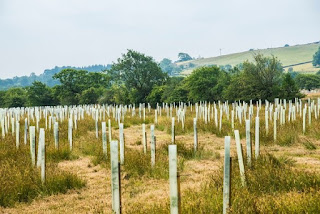By
Kristina Graves, Ribble Rivers Trust
Welcome to 2020 the start of a decade of
climate and conservation action!
We are all well aware of the biodiversity and
climate crises that are facing us. The extinction of hundreds of species, recent
fires in the Amazon and Australia, and, more locally, the recent floods that
have affected Lancashire and other areas within the UK should not be the legacy
of this decade, or even the year. The causes of these crises are varied and
numerous, and solving them (if at all possible) won’t be straight forward, and
it certainly won’t be easy; a combination of new technology, shifting behaviour
and embracing natural solutions must be a part of the answer.
One natural solution that is getting a lot of
media attention at the moment is woodlands, and rightly so. Woodlands are a
valuable tool in combatting the climate crisis.
Trees absorb carbon dioxide from the atmosphere as they grow and store it in their trunks, branches, roots
and leaves: a process called carbon sequestration.
Woodlands are also very good
at slowing the flow of water down the catchment and into the river. For
starters, their physical presence acts as a barrier to water flowing over the
ground both directly and indirectly, through encouraging the growth of a scrubby
understorey, which also
hinders surface water flow. Secondly, our soils generally benefit from
woodlands; they tend to be less compacted in the presence of trees, allowing
water to soak into the ground instead of running into the river. The roots of
trees and undergrowth anchor the soil in place meaning there’s more of it to
absorb water, and the less soil that is in the river means there is greater
capacity for water in the channel! Whilst more woodland won’t stop flooding
happening ever again, it will contribute to less devastating consequences for
people and homes after bouts of heavy rainfall.
Woodlands
also have the potential to support biodiversity. Firstly, woods are areas of trees and other plants that directly support
populations of floral species. Indirectly however, woodland creation supports
much more than manual population increase. Careful planning of woodlands can
improve connectivity between existing woodland patches and allows animals to
roam around a greater area of suitable habitat. Increasing the area of woodland
can also support a greater number of individuals and increase the capacity of
the woodland to support more species. Surprisingly perhaps, woodlands can
influence freshwater habitats too.
Nearby trees provide shade over river channels
and keep rivers cool, our science team at Ribble Rivers Trust have seen water
temperature increase by 9 degrees in an un-shaded reach of river, enough to wipe
out aquatic life! Leaf litter and branch fall from trees on the river banks provide
an important source of food for freshwater invertebrates and fish and create
different habitat types to support a wider range of species.
Finally, trees and
riverside vegetation prevent sediment and diffuse sources of pollution from the
catchment entering the water course and toxifying the habitat for species.
A third
benefit of increasing woodlands cover is the innumerable benefits that woodlands
have on our health. Air quality is becoming increasingly recognised as a
problem in the UK and is estimated to affect the lives of 40,00 people with respiratory problems. But where woodlands run along the
side of main roads and motorways, air quality is noticeably improved which will be a key benefit as emissions are increasing as we travel more. Activities
associated with delivering a woodland plan including tree-planting, woodland
management, fencing and litter picking encourage us to keep active in the
outdoors, and the increasing green space that results from the woodland will
encourage us to step outside more and improve our physical fitness and mental
health.
With all of
this in mind, we at the Ribble, Lune and Wyre Rivers Trusts have been busy
launching our Lancashire Woodland Connect campaign. Focusing on nature based
solutions, we have developed a plan to plant 500,000 trees across the whole of
Lancashire over the next 10 years. The campaign is supported by a number of
local authorities who acknowledge the many benefits woodlands provide. We will work
with local organisations
who are looking to improve the environment for the climate, biodiversity and
people and/or to offset any of their unavoidable CO2 emissions.
Historically,
we have planted over 150,000 trees in the Ribble catchment alone and have
therefore developed an evidence based method to ensure trees are planted where
they will provide the most benefit to the widest number of people. Data
collected from across the entire catchment allows us to identify priority areas
for reducing risk of faecal matter, risk of sediment input, risk of sun
exposure and risk of water input. We combine this information with knowledge of
catchments upstream of areas with high flood risk and the information about the
local landscape, habitats and wildlife to work out where trees will be most
beneficial for rivers, the landscape, wildlife and people.
It is no
mean feat getting 500,000 trees in the ground! Our woodlands are planted by a
team of enthusiastic volunteers who contribute their time and energy to planting
the 50,000 trees/year necessary to reach our targets. If you want to help us
improve Lancashire’s woodland cover to support our wildlife, environment and
our climate please get in touch.
Without dedicated people like you, this task would be a whole lot harder! Thank you





